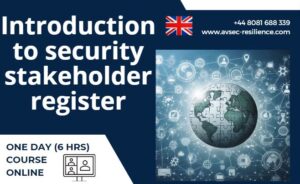Design & Developed by Themeshopy
Return To TopIntroduction to security stakeholder register
Introduction to security stakeholder register

Introduction to security stakeholder register
Duration: 1 days / 6 hours
Delivery method: Online/ In-company training
Target Audience: This course is designed for internal security departments
Cost: Available upon application
Language: English
Course code: ISR01
Introduction
A stakeholder register is a critical tool for a security department, providing a structured approach to managing and engaging with the various individuals and groups that have an interest in the company’s security operations. Regular and structured engagement with stakeholders builds trust and strengthens the security department reputation.
A stakeholder register serves as a vital tool for managing relationships and communication with stakeholders, ultimately enhancing operational efficiency, strengthening strategic alignment, and improving risk management. It supports better decision-making, supports regulatory compliance, and helps build a positive reputation, making it an indispensable part of effective companies security culture.
Course Objectives:
By the end of this course, participants will be able to:
- Understand the concept and significance of security stakeholder registers.
- Identify and categorise different types of security stakeholders.
- Develop a security stakeholder register tailored to your organisational needs.
- Analyse and prioritise stakeholder interests and concerns.
- Implement strategies for effective stakeholder communication and engagement.
- Maintain and update security stakeholder registers as part of continuous security management.
Difference between a Stakeholders register, Risk register and Shareholder register
- The primary purpose of a stakeholder register is to document all stakeholders involved in a project or organization, including their interests, influence, and engagement strategies.
- Type of Information: Contains information about stakeholders, their interests, influence, and engagement strategies.
- Outputs include communication plans, engagement strategies, and stakeholder analysis reports.
- The primary purpose of a risk register is to document all identified risks associated with a project or operation, along with their assessment and management plans.
- Type of Information: Contains information about risks, their likelihood, impact, and mitigation plans.
- Outputs include risk mitigation plans, contingency plans, and risk status reports.
- Shareholder Details: The name and address of each shareholder.
- Number of Shares: The number of shares held by each shareholder.
- Share Classes: The class of shares held by each shareholder (if there are different classes).
- Dates: The date when each shareholder was registered and any changes in shareholdings.
- Unique Identifiers: Sometimes includes unique shareholder identification numbers.
- Number of Shares: The number of shares held by each shareholder.
Potential course benefits, the why
SWOT on creating a security stakeholder register
- Complete Information: Captures detailed information about all stakeholders involved in security, including their roles, responsibilities, and contact information.
- Centralized Data: Provides a single point of reference for all security-related stakeholder information, facilitating easy access and management.
- Clarity and Accountability: Clearly defines the roles and responsibilities of each stakeholder, which can help in reducing misunderstandings and ensuring accountability.
- Efficient Coordination: Enhances coordination among stakeholders by providing a clear communication pathway.
- Risk Identification: Helps in identifying and understanding potential security risks through detailed stakeholder analysis.
- Proactive Measures: Enables proactive management of security issues by keeping relevant stakeholders informed and engaged.
- Regulatory Adherence: Assists in meeting regulatory requirements by maintaining detailed records of stakeholder roles and actions related to security.
- Efficient Coordination: Enhances coordination among stakeholders by providing a clear communication pathway.
In-house courses
Zoom is a default setting for this course, it could be delivered via Microsoft Teams or Webex.
Jump to internal page: Contact us
















